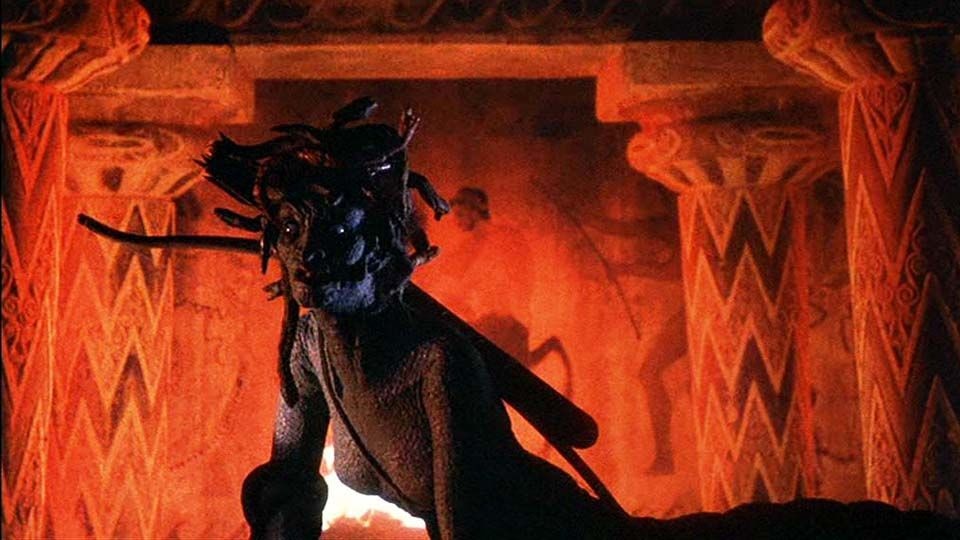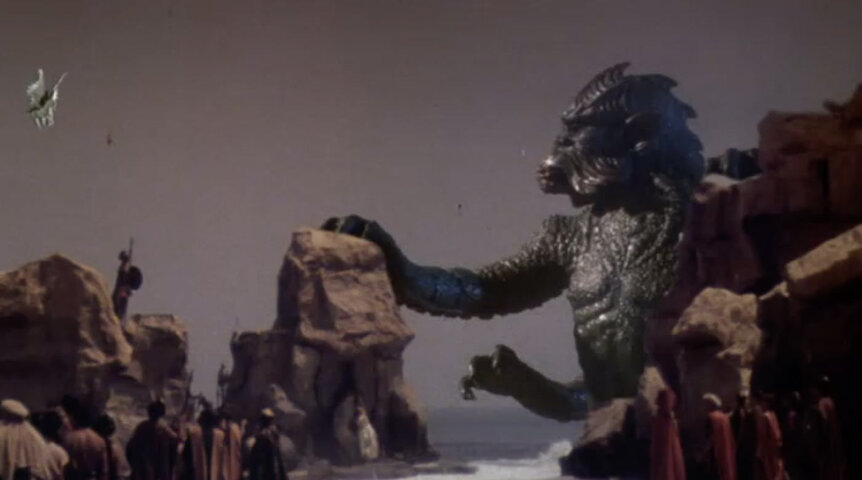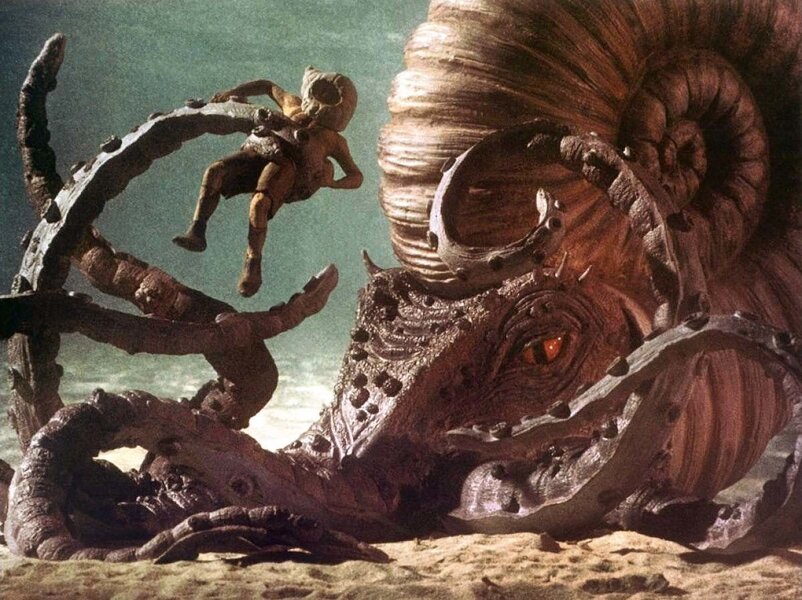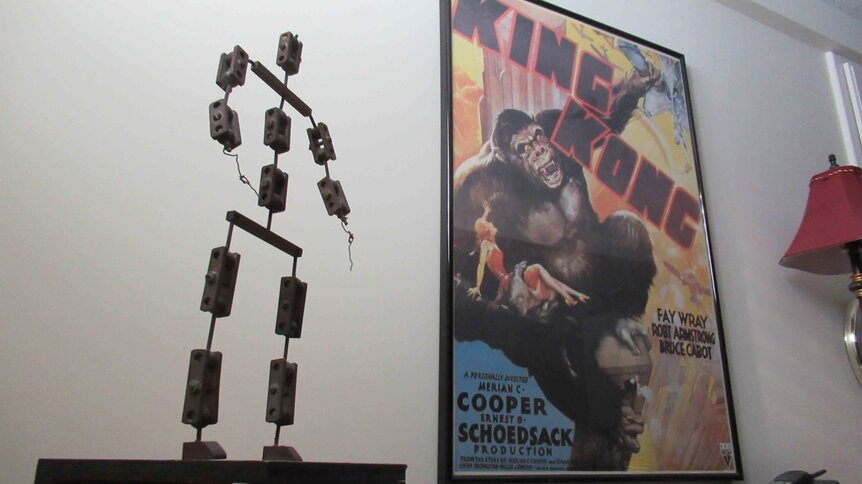Create a free profile to get unlimited access to exclusive videos, sweepstakes, and more!
Remembering Ray Harryhausen, one of the greatest special effects artists in movie history

Almost six years have gone by since the passing of stop-motion animator Ray Harryhausen. Harryhausen, who died on May 7, 2013 at the age of 92, was one of the major special effects artists of the 20th century, inspiring generations of filmmakers and pop culture enthusiasts with his extravagantly animated dinosaurs, rampaging monsters, sword-wielding skeletons, and various other stop-motion creations.
Much can be said — and has been said — about the enduring appeal of Harryhausen's movies, which include The Beast from 20,000 Fathoms (1953), The 7th Voyage of Sinbad (1958), Jason and the Argonauts (1963), One Million Years B.C. (1966), and Clash of the Titans (1981). So, to offer a more intimate portrait of this major artist, SYFY WIRE sat down for a conversation with film historian Bruce Crawford.
Based in Omaha, Nebraska, Crawford interviewed Harryhausen in the late 1980s for his acclaimed radio documentary on composer Bernard Herrmann, the man who scored four of Harryhausen's movies. A couple of years later, in 1992, he arranged to bring Harryhausen to Omaha for a screening of two of his movies, which marked the genesis of an annual series of classic film events which Crawford continues to host in Omaha to this day. Harryhausen returned to Omaha as Crawford's guest for a screening of the original King Kong (1933), the film which inspired him to become a stop-motion animator.
Crawford's personal association with the legendary special effects artist goes far beyond those two events, as he was one of Harryhausen's closest friends.
How did you first become acquainted with Ray Harryhausen? What was the first movie of his you saw, and how did you come to know him personally?
The first movie of Ray's I saw was Mysterious Island (1961). I saw it in a theater; I was just a little kid, probably not even five years old. I couldn't read the names in the credits at that age, and it was the music by Bernard Herrmann that captivated me more than anything, at first. But, I loved the film and I tried to catch Mysterious Island as often as I could when it appeared on TV. And that was when I started reading the credits and seeing Ray's name more and more and remembering who he was. And I started enjoying films like Jason and the Argonauts (1963) and First Men in the Moon (1964) and realizing he had done the special effects for those movies as well.
I would look for any merchandise I could find on Mysterious Island and I remember getting a magazine called FXRH — "FX" being an abbreviation for "Effects" and "RH" standing for "Ray Harryhausen." And I started corresponding with the editors, Ernest Farino and Sam Calvin. I started writing to them as well as other people such as Craig Reardon, who's become a legendary makeup artist in Hollywood, working on Poltergeist (1982) and E.T. the Extra-Terrestrial (1982) and other films.
I started corresponding with Ray through letters in the late '70s as a teenager. And in the early '80s, I called his home in Pacific Palisades, Los Angeles. He had two homes; the other one was in London. At the time, Darlene O'Brien resided in his Los Angeles home. She was the widow of Willis O'Brien, the special effects creator of the original King Kong (1933), the movie which inspired Ray to become a stop-motion animator in the first place. She and I hit it off really well, and she told me she would introduce me to Ray over the phone the next time he was in Los Angeles.
The first time we spoke was in late May/early June 1981, when Clash of the Titans was coming out. I'd seen the film with a preview audience the day before. Ray had just arrived from London to promote the film. I told him how the theater had been jam-packed and that people had cheered and applauded and I told him, "Mr. Harryhausen, if the preview audience I saw was any indication, you're going to have a really big hit on your hands."
He started asking me all kinds of questions. "What did they think of this scene? What was their reaction to that scene?" I still remember him asking me what the age groups in the audience were; he was very interested in knowing. And, of course, the film was very successful, one of the top ten hits of the summer. And the next year, in 1982, I got to meet him in person, at his home in Pacific Palisades, and we just hit it off and became really good friends.
You've said it was because of Ray Harryhausen that your career as a film historian got started, that you owe it all to him.
He's the reason my documentary on Bernard Herrmann took off, because he was the first person who agreed to be interviewed. Once I got him, I told other potential interviewees that he was contributing, and that just brought everybody else onboard; they knew right there and then that we were legitimate. It was because of Ray that I got people like Leonard Maltin, producer Tony Thomas, composer Fred Steiner, and the Herrmann family. And the Herrmann documentary went worldwide; it established me. It's so successful, still.
In 1992, he won his Honorary Award at the Oscars. I called him afterward and said, "I've got to get you here to Omaha." And he said, "Well, you know, Bruce, I don't sing and dance with a straw hat and cane." We had a double feature at a theater that's sadly no longer here called the Indian Hills, which had a gigantic 105-foot-wide Cinerama screen. We showed my favorite of his movies, Mysterious Island, as well as his personal favorite, Jason and the Argonauts. We had a decent print of Mysterious Island and a brand new print of Jason and the Argonauts. I brought in Ray and his wife, Diana, and as they say, the rest is history.
When I did that first movie event, it never entered my mind that this would be something I would ever do again. But come May of this year, I will have done 44 events here in Omaha. All because of him. He basically started my whole career as a film historian and a producer and a host honoring classic cinema. So he's responsible for many people's careers in many areas, not just special effects. And he certainly was for me and what I do.
After the movie event in 1992, we became even closer. In 1995, we went on a dinosaur dig in Canada. I was with him when he got his star on the Hollywood Walk of Fame in 2003. When Ray's wife became ill when he was to receive a lifetime achievement award at Pinewood Studios in December 2005, I went with him as his "date." [laughs]
And in 2001, 2005, and 2008, I would spend a week or two at his house in London. Just hang out, have fun, and do things together. My bedroom was right next to his office, where he had all his stop-motion models from his movies. And even though I was a man in my 40s then, he would joke and say, "Now, Bruce, if you hear any noises or any scratching sounds coming from the other side of the wall, that's just my creatures walking around in my office." His daughter Vanessa said to me, "Dad would say that to you whether you were 9 or 90."
Speaking of models, Mr. Harryhausen helped you create a stop-motion puppet of your own.
This was the time when Ray and I were corresponding through letters. I was about eighteen years old. And he sent me, from England, a simple pencil sketch of a humanoid ball-and-socket armature (the metal skeleton which allows the puppet to move and hold its place for animation). My dad was a machinist and Ray's dad had been a machinist, too, incredibly enough. So my dad was able to help me build the armature. He cut the metal pieces and I welded it together. We built a whole puppet, including the foam rubber skin.
I mentioned Ernest Farino earlier. He's since gone on to become an accomplished special effects man and he showed me how to do the clay sculpturing, the plaster casting, how to pour the foam rubber to make the skin, etc. I made my own stop-motion cyclops, similar to what Peter Jackson did when he was 14 — although his puppet had a wire armature, mine was a ball-and-socket like those Ray used. After all, it was Ray who had sketched the design for my armature.
I made an 8mm movie with it, too. I used rear-screen projection and used tie-down holes (little holes drilled into the animation table through which screws can be locked into the puppet's feet to keep it standing while animating) and animated it one frame at a time, just like Ray and others had done. I had my cyclops walking on a beach like in the opening of The 7th Voyage of Sinbad. Ray got a big kick out of it when I showed it to him.
Of course, the foam rubber has deteriorated since then, but I still have the armature.
Mr. Harryhausen was openly critical of the 1976 remake of King Kong, saying that if that had been the movie that had played in 1933, he probably would've become a plumber instead of a stop-motion animator. I understand you accompanied him to the London premiere of the second King Kong remake in 2005. What did he think of the second retelling of the King Kong story?
That happened during my second visit to his home in London, in December 2005. I tagged along with him to the premiere since I just happened to be visiting. Director Peter Jackson and several of the cast members were there at the premiere as well. Ray thought it was a wonderful homage to the original film, and I think he even told Peter this. He did think it might've been an hour too long for him, and that the film didn't necessarily need the backstory on Naomi Watts' character. But he loved the film overall.
Any last thoughts on Ray Harryhausen that you would like to share?
He was everything I thought he would be. He never disappointed me on any level, as a human being, as an artist, as a filmmaker. I cannot explain how it happened. A kid from Nebraska bringing him here, later visiting his home in London three times, growing close to him, going with him when he received a lifetime achievement award at Pinewood Studios in London, being considered part of the family and vice versa. I never imagined it.
It just doesn't seem real to me sometimes — and yet at the same time it seems totally, perfectly natural. Something I'll never forget: we were in his kitchen at my last visit at his home. I don't remember what we were talking about before, but I said to Ray, "I believe in destiny. It was kind of meant to be." And he said, "Absolutely."





























